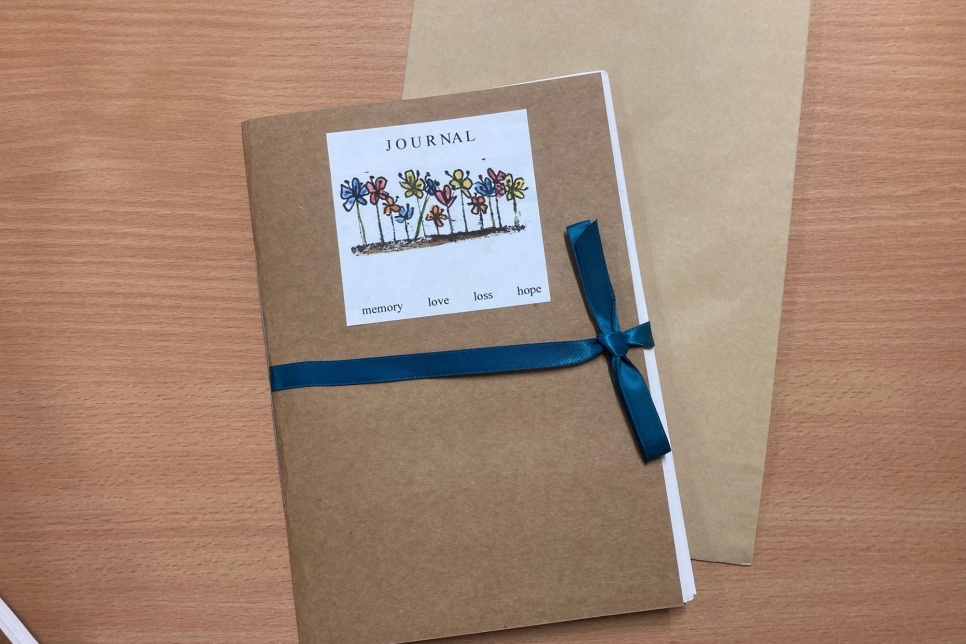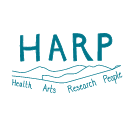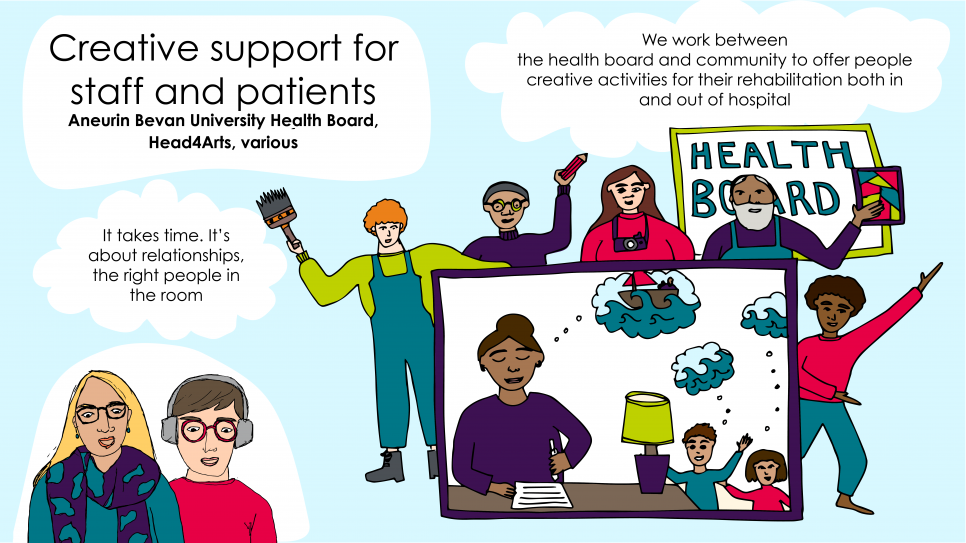Aneurin Bevan University Health Board’s Sarah Goodey, Arts Development Manager, and Eleanor Davis, Arts and Health Project Officer, join Kate Strudwick, Creative Director of Head4Arts, to share their HARP journey…
The pandemic put health organisations under incredible pressure.
Staff went above and beyond to protect people from the virus while supporting patients with other health conditions and attempting to manage their own circumstances.
Everyone’s mental health has been under strain – staff and patients alike.
Keen to elevate best practices in arts and health, Aneurin Bevan University Health Board (UHB) partnered with Gwent Arts in Health and community arts organisation Head4Arts to deliver a range of activities to different groups of people focused on mental health and bereavement.
With HARP’s support, during the past year, we have used these activities to explore how to embed arts in the Health Board by collecting learning and evidence of best practice and advocating new approaches across specialisms.

Supporting those grieving and the young
Support services for people experiencing bereavement were disrupted during lockdown and restrictions compounded the isolation many people feel when grieving.
To explore how creativity could help, we introduced a butterfly paper-folding activity for volunteers with the hospital’s end-of-life service as an act of remembrance that could be done at patients’ bedsides. A package contained the necessary materials and information on grief and bereavement services.
People often worry they will forget things about the person who has died, so a creative bereavement journal was trialled by 18 volunteers. It offers ideas for written reflection, is a helpful counselling tool, and is a beautifully crafted gift that health service staff can give relatives at a time when they often feel powerless to help.
Staff and artists also accessed training from the charity Cruse on the impact of bereavement.
Working with MyST (My Support Team), a multiagency partnership working to help children who are looked after remain in their local communities, ABUHB Child Psychology Transformation Programme, Blaenau Gwent Families First and Gwent Child Family and Community Psychology, we were also able to explore how creative practice can have a positive impact on children and young people’s mental health and well-being.
Children living in difficult circumstances are more likely to experience challenges with their mental health and wellbeing as they grow up and these effects have been amplified during Covid-19.
With Families First, we ran poetry workshops in Blaenau Gwent with mothers whose families have been identified as needing additional support. The sessions were facilitated by a local poet, Clare Potter, and the families’ support workers participated, helping build trust. Participants felt the project helped them express how they were feeling and why, and led to them making different life choices.
Working with MyST we have supported young people to explore their sense of belonging and how this can have a positive impact on their mental health through visual arts. The sessions, led by artist Ben Connors and Amelia Thomas, were attended by young people and their support workers. They created artworks and graffiti that is now part of the fabric of their centres. This creates an important opportunity of representation for young people who often feel undervalued and unseen.
Importantly, these activities were a testbed to promote and grow an arts and health ecology within the health board.
Our experiences with them, and the impact they had, fed into a creative forum that we started in parallel to facilitate conversations about what arts and health have to offer Aneurin Bevan UHB. The forum often featured guest artists.
The conversations at the forum and the activities helped build, test, and refine the Health Board’s first arts strategy, which is now in its final stages and will steer this work for years to come.
These activities were a testbed to promote and grow an arts and health ecology within the health board
Transforming challenges into learning opportunities
As expected, not everything has gone to plan.
Competing demands on staff capacity delayed plans for textile and sound projects, though we remain committed to them happening, and made regular meetings between partners difficult.
We also had to make the case for arts and health work being critical during a pandemic when the NHS was stretched and services were either shutting down or moving online. We did so through the creative forum, strategy, and advocacy.
There were periods during the pandemic when public services weren’t running but commercial enterprises were, which amplified health and social inequalities.
For vulnerable children, young people, and families, maintaining in-person access to their support system during Covid-19 was critical to their wellbeing. We successfully advocated creative workshops for them continued in person during the second lockdown.
There were lessons learned, too.
Transformative conversations happened when facilitators were willing to share their vulnerabilities alongside learners during workshops, particularly those working with young people.
And having NHS health specialists and clinical partners involved in community sessions helped artists feel supported and created safe spaces for participants. Their involvement also meant the creative work and conversations that came from it could be integrated into individuals’ health
and social care plans. Some of the sessions for young people, for example, were supported by the child psychology team.
Our work has also highlighted how staff have been affected by bereavement. We are now looking at how the bereavement journals can support them as well as patients.
Remote working has brought positive change. Our creative forum sessions brought staff of different management levels and specialisms together as equals online. Everyone is the same size in a Zoom or Teams window.
Creating an arts and health legacy
At an activity level, our project contributed to a growing understanding of the power of creativity to make a difference to people’s mental health and well-being. They allowed patients to see themselves, to have a voice and see their work valued enough to be given space. They also allowed patients choice about how and what they shared.
All of the activity threads we have created through HARP will have resonance as we move forward, as will the partnerships we have built.
Following interest from an organisation in Blaenau Gwent, for example, we have secured funding for creative workshops for young people with disabilities and young carers. That organisation is keen to embed arts practice in its work.
The textile and sounds projects will run with patients in acute settings, providing solace and enabling them to experience an alternative environment.
We will also look to augmented reality and technology to provide a break to staff who can’t physically leave their wards.
Our creative bereavement work will continue. We are developing in-person and remote group activities, exploring a supported walk-in model and how to incorporate outdoor activities.
We are proud of the impact this project has had on individuals, families, our artists and our health staff.
At the end of an eight-week poetry workshop, a mum who had participated made a life-changing decision that improved the family’s safety, which she directly attributed to the workshop.
Finally, the adoption of our arts strategy by the Health Board represents a significant shift for future practice.
Now, arts in health will be considered as a way of hearing patients’ voices, increasing their participation, enhancing their physical environments. It means that where possible and appropriate this will be included within the health board.
Those who joined our creative process reported finding strength and support in both the designing of the strategy and spending regular time considering creativity with a broad spectrum of colleagues.
We are now looking forward to implementing this strategy with them and learning from these HARP-supported creative activities and ongoing activity streams.
The Arts and Health Programme was a partnership between Aneurin Bevan University Health Board, Gwent Arts in Health, Head4Arts and individual practitioners.

